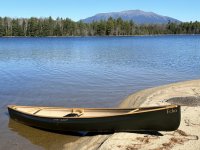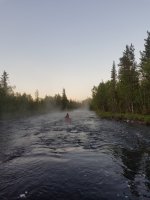I just finished a four day trip (packed for five) paddling the Esquif Echo around the Debsconeag Loop just south of Mt Katahdin here in Maine. If you know this canoe route, then you know it includes some very large lakes known for wind and a section of the Penobscot River that includes class II rapids with class IV options if you dare. It was, you might say, a good test of this neat little boat.
The stats for the Echo, from the Esquif website:
I set off from Spencer Cove in quiet water loaded with 70 pounds of gear and food plus my 210 pound self. With 280 pounds, the boat still felt agile and didn't feel near maxed out. My guess is that I could easily have carried 325 pounds and still enjoyed the paddling. I firmly believe it could have packed for 10 days without pushing the limits of this boat.
I have read comments that the boat is too wide for a solo. That's true if you want to paddle Minnesota style. I paddled this Canadian style, keeled over. Paddled this way, it wasn't as fast as my Nova Craft PAL but it was fast enough. It was also incredibly stable, in fact more stable the more it was keeled over. I will say this, though. You will be frustrated by this boat if you don't have good form when it comes to correction strokes. However, for the competent paddler, this boat is easy to keep on track.
As I came around the first islands in Spencer Cove, I was greeted with a headwind and large swells and scattered white caps from the 3.5 mile catch on Ambajejus Lake. I hesitate to assess how big the swells are -- they always look bigger when you're in them than they look from shore. I will say it was the second largest water I've paddled in this year. And I felt completely confident in the boat, despite its 11.5" center depth.
This trip requires four portages (unless you want to paddle class III-IV), including a two mile section that will accommodate wheels, a .3 mile carry with hills, a 1 mile carry on a rocky section and a short jaunt across a mid-river island to bypass those big rapids. I doubled each portage. I will say the Echo seems to weigh a bit more than the listed 45 pounds and seems heavier than my 52 pound PAL. But as a semi-fat old guy, I never felt overly strained by the load. That may be because I carried it after carrying a 60 pound pack with 10 pounds in my hands. Still, it seemed a reasonable weight.
After Amabejejus, the water was unusually calm until I approach the first set of rapids on the Penobscot River. This was class II water with clear lines but also with several ledge drop offs, and the Echo, while not running as dry as a Prospecteur, was buoyant, stable and predictable. In fact, I purchased the boat just for this trip, knowing that I wanted something that could transition from lakes to rivers gracefully. I misjudged one drop off and glided over a rock -- my first scratch! No worries, though. Later, when I turned the boat over, I saw that the T-formex material had endured quite nicely, with a shallow scratch where I expected something deep and nasty.
I believe the Echo is a boat to be taken seriously, especially for anyone who travels mixed routes and even lake routes with rocky landings. Is it the right boat for a wilderness trip on some far north river? No. But on every body of water short of that, it will carry everything you need for an overnight up to a 10 day trip. It will handle class II water with a load and it will look good (very good) doing it. I have nothing but good things to say about the Echo.
The stats for the Echo, from the Esquif website:
- Construction : T-Formex
- Length : 4.27 m (14′ )
- Width : 80.9 / 75.2 cm (31 7/8 – 29 5/8″)
- Depth : 29.2 cm (11.5″)
- Shape : Shallow Arch
- Rocker : 4.4 cm (1.75″) bow and stern
- Gunwale : Wood
- Colour : Green, Tan
- Weight : 20.5 kg (45 lbs)
- Seats : Webbed
I set off from Spencer Cove in quiet water loaded with 70 pounds of gear and food plus my 210 pound self. With 280 pounds, the boat still felt agile and didn't feel near maxed out. My guess is that I could easily have carried 325 pounds and still enjoyed the paddling. I firmly believe it could have packed for 10 days without pushing the limits of this boat.
I have read comments that the boat is too wide for a solo. That's true if you want to paddle Minnesota style. I paddled this Canadian style, keeled over. Paddled this way, it wasn't as fast as my Nova Craft PAL but it was fast enough. It was also incredibly stable, in fact more stable the more it was keeled over. I will say this, though. You will be frustrated by this boat if you don't have good form when it comes to correction strokes. However, for the competent paddler, this boat is easy to keep on track.
As I came around the first islands in Spencer Cove, I was greeted with a headwind and large swells and scattered white caps from the 3.5 mile catch on Ambajejus Lake. I hesitate to assess how big the swells are -- they always look bigger when you're in them than they look from shore. I will say it was the second largest water I've paddled in this year. And I felt completely confident in the boat, despite its 11.5" center depth.
This trip requires four portages (unless you want to paddle class III-IV), including a two mile section that will accommodate wheels, a .3 mile carry with hills, a 1 mile carry on a rocky section and a short jaunt across a mid-river island to bypass those big rapids. I doubled each portage. I will say the Echo seems to weigh a bit more than the listed 45 pounds and seems heavier than my 52 pound PAL. But as a semi-fat old guy, I never felt overly strained by the load. That may be because I carried it after carrying a 60 pound pack with 10 pounds in my hands. Still, it seemed a reasonable weight.
After Amabejejus, the water was unusually calm until I approach the first set of rapids on the Penobscot River. This was class II water with clear lines but also with several ledge drop offs, and the Echo, while not running as dry as a Prospecteur, was buoyant, stable and predictable. In fact, I purchased the boat just for this trip, knowing that I wanted something that could transition from lakes to rivers gracefully. I misjudged one drop off and glided over a rock -- my first scratch! No worries, though. Later, when I turned the boat over, I saw that the T-formex material had endured quite nicely, with a shallow scratch where I expected something deep and nasty.
I believe the Echo is a boat to be taken seriously, especially for anyone who travels mixed routes and even lake routes with rocky landings. Is it the right boat for a wilderness trip on some far north river? No. But on every body of water short of that, it will carry everything you need for an overnight up to a 10 day trip. It will handle class II water with a load and it will look good (very good) doing it. I have nothing but good things to say about the Echo.

Last edited:

